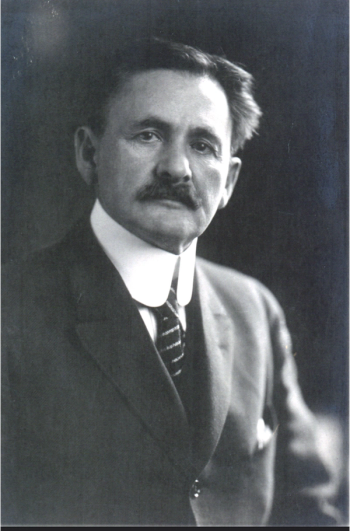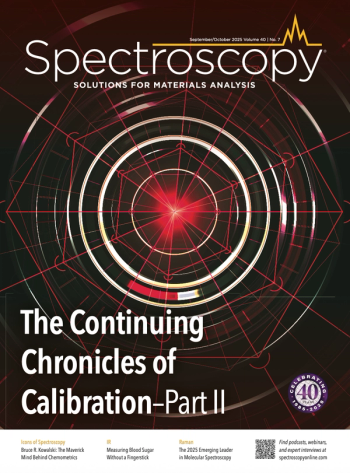
Using FT-IR Spectroscopic Imaging in Both ATR and Transmission Modes
Key Takeaways
- FT-IR spectroscopic imaging, especially in ATR mode, offers higher spatial resolution, enhancing biomedical and pharmaceutical analysis capabilities.
- ATR-FTIR imaging combined with microfluidics allows for dynamic analysis of protein stability under flow, reflecting real-world bioprocessing conditions.
Spectroscopy sat down with Sergei Kazarian and Bernadette Byrne to talk about their latest research collaboration, which offers insights into why FT-IR spectroscopic imaging is advantageous in biomedical and pharmaceutical analysis.
Sergei G. Kazarian is a Professor of Physical Chemistry in the Department of Chemical Engineering - Faculty of Engineering at Imperial College London. Kazarian’s work focuses on advanced vibrational spectroscopy, with expertise in Fourier transform infrared (FT-IR) and Raman spectroscopic imaging for material and biomedical analysis. It involves developing FT-IR chemical imaging methods for characterizing materials, pharmaceuticals, nanostructures, forensic samples, and cultural heritage objects (1). Kazarian also applies Raman spectroscopy for studying polymeric and biomedical materials through techniques like confocal and tip-enhanced Raman microscopy (1).
At the 2025 SciX Conference, Kazarian discussed his most recent collaboration with Professor Bernadette Byrne, a Professor of Molecular Membrane Biology in the Department of Life Sciences at Imperial College London, which focused on the use of vibrational spectroscopy techniques to investigate therapeutic antibody behavior (2).
Spectroscopy sat down with Kazarian and Byrne to talk about their latest research collaboration, which offers insights into why FT-IR spectroscopic imaging is advantageous in biomedical and pharmaceutical analysis.
Your research highlights the use of FTIR spectroscopic imaging in both attenuated total reflection (ATR) and transmission modes. What are the main advantages of each mode, and how do they complement one another in biomedical and pharmaceutical analysis?
Sergei G. Kazarian (SGK): The use of a focal-plane array infrared (IR) detector has enabled the simultaneous collection of multiple IR spectra to form spectroscopic images within seconds.
FT-IR spectroscopic imaging is commonly achieved in transmission, in which the IR beam passes through a sample that is mounted on one or between two IR transparent windows. The principal disadvantages of transmission are that the sample must be thin and less than 20 micrometers. Analysis of aqueous samples using this technique is challenging because of the strong absorption of water. Transmission is the most common research approach for biopsies sectioned to approximately 10 mm thickness and mounted on an IR transparent window.
Initially, biomedical applications of FT-IR imaging were mainly performed in transmission mode. However, the potential of studies of dynamic systems in transmission mode was limited by the very thin samples. We have demonstrated that FT-IR imaging in attenuated total reflection (ATR) mode can provide images with much higher spatial resolution. There are two ATR-FTIR imaging modes: micro and macro. In our view, macro ATR-FTIR spectroscopic imaging is the most versatile and powerful chemical imaging technique and analytical approach. This approach has been applied to the analysis of pharmaceuticals (3,4).
However, micro ATR-FTIR is also useful. We demonstrated for the first time the application of micro ATR-FTIR spectroscopic imaging with a variable angle of incidence to obtain a depth profile of tissue samples. This novel investigation revealed new analytical insight into the variation of tissue composition with depth in a non-destructive manner and could improve cancer diagnostics (5). In this work, spatial resolution was sub-micrometer. Diagnostic applications with machine learning were recently developed in FT-IR spectroscopic imaging of colon tissues using innovative approach with large area Ge crystal (6).
FTIR spectroscopic imaging of colon biopsy tissues in transmission combined with machine learning for the classification of different stages of colon malignancy was developed in this study. The additional lens implemented to correct for the chromatic aberration in infrared measurement is referred to as ‘correcting lens’ (7). We discuss this more in our recent perspectives article (8).
Could you elaborate on how improvements in spatial resolution have expanded FT-IR’s diagnostic or analytical capabilities?
SGK: Initially, biomedical applications of FT-IR imaging have mainly been performed in transmission mode, but we have demonstrated that FT-IR imaging in attenuated total reflection (ATR) mode can provide images with much higher spatial resolution.
The most recent developments in the field of FT-IR spectroscopic imaging have been discussed in review articles by both us and other researchers in the field. However, the potential of studies of dynamic systems in transmission mode was limited by the very thin samples.
There are two ATR-FTIR imaging tools: micro and macro. Micro-ATR imaging has opened many new areas of study that were previously precluded by inadequate spatial resolution. For macro ATR-FTIR spectroscopic imaging, we've used and developed this methodology in our laboratory since 2002.
Protein aggregation is a major concern in the development of biotherapeutics such as monoclonal antibodies (mAbs). How has ATR-FTIR spectroscopic imaging helped reveal new insights into the mechanisms of protein aggregation at the air–liquid interface?
SGK and Bernadette Byrne (BB): This important work came about from our attempt to study mAb under flow, which is a stress experienced at several points in the bioprocessing pipeline. We found that air was often introduced randomly into our microfluidic channels, likely recapitulating a phenomenon also occurring during downstream processing. Very quickly, by using ATR-FTIR spectroscopic imaging, it became clear that the air bubbles stimulated the formation of heavy mAb deposition at the air–liquid interface. Detection of this deposition was possible since ATR-FTIR imaging can detect differences in protein concentration. Using the unique power of ATR-FTIR imaging and the information stored in the spectra obtained under different conditions, we were able to demonstrate that not only was protein depositing, but also that it was aggregating because of changes to the secondary structure of the mAb. In addition, we showed that the surfactant, PS80, inhibited aggregation at 30 ºC but not at 45 ºC. This builds on work that we have previously carried out showing how protein aggregates in the presence of different buffer conditions and how column-based interactions can influence mAb status (9).
Your observed structural changes in proteins at different temperatures and pH levels, including the formation of intermolecular beta sheets. What do these findings suggest about the stability of biopharmaceutical formulations under real-world processing conditions?
BB: The changes at the level of molecular structure including the formation of intermolecular beta sheets are typical of aggregation of the mAbs. In our experiments, we accelerate this process through heating (usually to 45 ºC) of the protein samples. Although the proteins in a typical bioprocess will not reach this high temperature, this serves to allow us to measure changes over a timeframe useful for experiments. However, under real world conditions, the proteins are exposed to a range of stresses, including dramatic changes in pH, concentration, the presence of air bubbles, and the application of shear forces which could combine to overall reduce the stability of the proteins and increase likelihood of the formation of aggregation (10).
Integrating ATR-FTIR imaging with microfluidics is a particularly innovative aspect of your work. How does this combination improve the analysis of protein structural stability under flow compared to traditional, static measurements?
BB: The combination of ATR-FTIR imaging with microfluidics allows us to study the sample under flow, which is its main state for much of the downstream process. Thus, this is more representative of specific parts of the process than static measurements. That is not to say that static measurements are not helpful. Indeed, these have been particularly useful for exploring protein on-column and for investigating the behavior of protein at formulation concentrations and conditions. Thus, a combination of both types of analysis makes ATR-FTIR useful for capturing behavior at virtually every point along the downstream process pipeline (11,12).
Part II of our interview with Kazarian and Byrne will focus on the future of FT-IR imaging, and they will explain where ATR-FT-IR imaging is heading in the future, and how it will be adopted in the biopharmaceutical industry.
References
- Imperial College London, Sergei G. Kazarian. Imperial College London. Available at:
https://profiles.imperial.ac.uk/s.kazarian (accessed 2025-11-07). - Imperial College London, Bernadette Byrne. Imperial College London. Available at:
https://profiles.imperial.ac.uk/b.byrne (accessed 2025-11-07). - van Haaren, C.; De Bock, M.; Kazarian S. G. Advances in ATR-FTIR Spectroscopic Imaging for the Analysis of Tablet Dissolution and Drug Release. Molecules 2023, 28, 4705. DOI:
10.3390/molecules28124705 - Tatsumi, Y.; Shimoyama, Y.; Kazarian, S. G. Analysis of the Dissolution Behavior of Theophylline and Its Cocrystal Using ATR-FTIR Spectroscopic Imaging. Mol. Pharma. 2024, 21 (7), 3233–3239. DOI:
10.1021/acs.molpharmaceut.4c00002 - Song C. L., Kazarian S. G. Three-dimensional Depth Profiling of Prostate Tissue by Micro ATR-FTIR Spectroscopic Imaging with Variable Angle of Incidence. Analyst 2019, 144, 2954–2964. DOI:
10.1039/C8AN01929K - Song, C. L.; Kazarian, S. G. Micro ATR-FTIR Spectroscopic Imaging of Colon Biopsies with a Large Area Ge Crystal. Spectrochimica Acta Part A: Mol. Biomol. Spectrosc. 2020, 228, 117695. DOI:
10.1016/j.saa.2019.117695 - Song, C. L.; Vardaki, M. Z.; Goldin, R. D.; Kazarian, S. G. Fourier Transform Infrared Spectroscopic Imaging of Colon Tissues: Evaluating the Significance of Amide I and C–H Stretching Bands in Diagnostic Applications with Machine Learning. Anal. Bioanal. Chem. 2019, 411, 6969–6981. DOI:
10.1007/s00216-019-02069-6 - Kazarian, S. G. Perspectives on Infrared Spectroscopic Imaging from Cancer Diagnostics to Process Analysis. Spectrochimica Acta Part A: Mo. Biomol. Spectrosc. 2021, 251, 119413. DOI:
10.1016/j.saa.2020.119413 - van Haaren, C.; Byrne, B.; Kazarian, S. G. Study of Monoclonal Antibody Aggregation at the Air–Liquid Interface Under Flow by ATR-FTIR Spectroscopic Imaging. Langmuir 2024, 40 (11), 5858–5868. DOI:
10.1021/acs.langmuir.3c03730 - van Haaren, C.; Byrne, B.; Kazarian, S. G. Assessment of IgG Stability in Low pH Elution Buffer Using ATR-FTIR Spectroscopic Imaging and Microfluidics. Analyst 2025, 150, 4201–4210. DOI:
10.1039/D5AN00664C - Beattie, J. W.; Rowland-Jones, R. C.; Farys, M.; Tran R.; Kazarian S. G.; Byrne, B. Insight into Purification of Monoclonal Antibodies in Industrial Columns via Studies of Protein A Binding Capacity by In Situ ATR-FTIR Spectroscopy. Analyst 2021, 146, 5177–5185. DOI:
10.1039/D1AN00985K - Boulet-Audet, M.; Kazarian, S. G.; B. Byrne, B. In-column ATR-FTIR Spectroscopy to Monitor Affinity Chromatography Purification of Monoclonal Antibodies. Sci. Rep. 2016, 6, 30526. DOI:
10.1038/srep30526
Newsletter
Get essential updates on the latest spectroscopy technologies, regulatory standards, and best practices—subscribe today to Spectroscopy.





